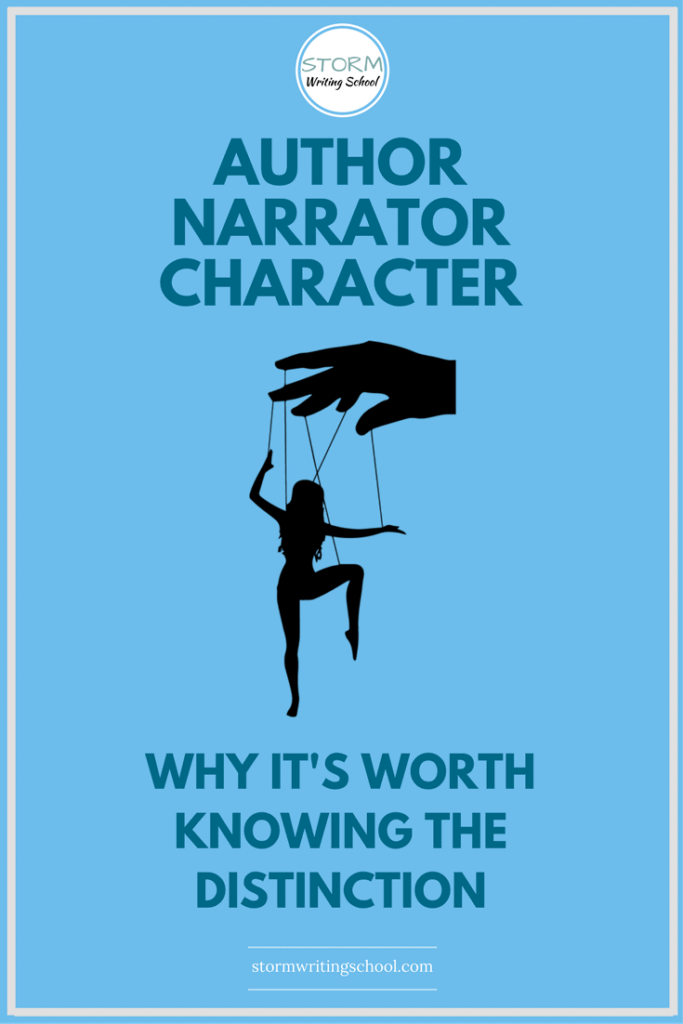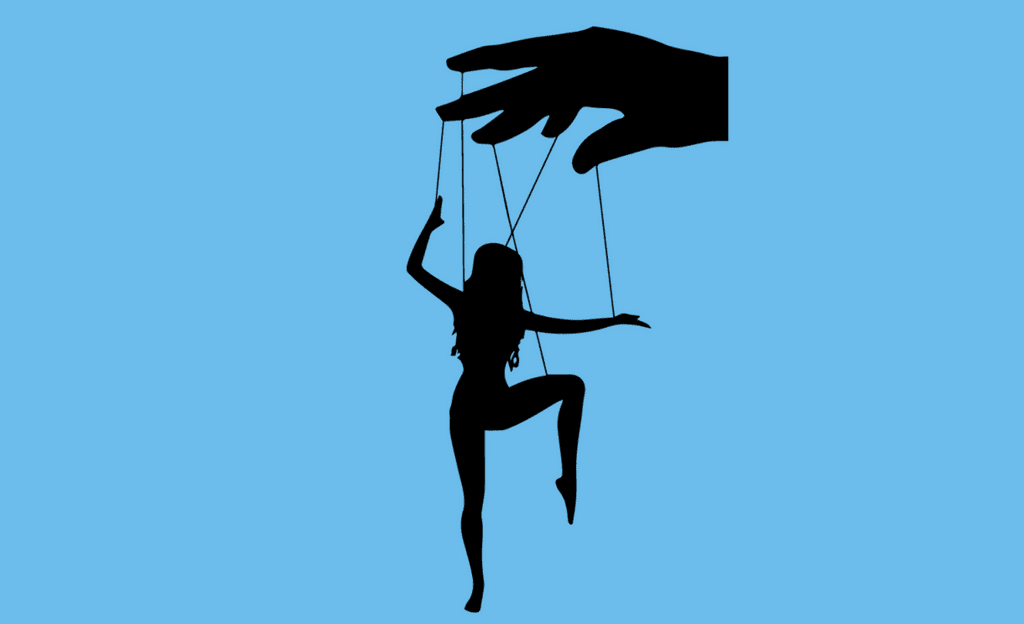There is a distinction between author, narrator, and character.
The author creates the story.
The narrator tells the story.
The character lives the story.
These are three distinct entities, which exist on different planes. Writers who don’t know the distinction can often end up with some sloppy narration and/or can come across as writerly.
So let’s unpack it.

The trickiest situation for distinguishing these three entities is in a first-person, autobiographical, nonfiction narrative. So we’ll use that POV as our exemplar.
Here’s a very brief passage from the middle of a “Reader’s Write” story from The Sun Magazine:
After the first snows covered the fallen leaves, I took a walk to stay busy, padding through a pale, uninhabited landscape. I stopped in a small clearing and, with a smile and mild sense of panic, said to myself, “I’m lost.” Though I couldn’t say where I was, there was nowhere else I would rather have been.
As I stood there, I became aware that I was not alone. A small gray-and-gold coyote was looking at me with a tilted head. I tried not to breath. I had seen many a shy fellow like him trotting along a meadow on a warm day at dusk, but this coyote wasn’t alone. Standing in a circle around me, I realized, was an entire pack. (Jennifer Molidor, Nov. 2017)
The character exists within the story.
In the above passage, she is the young woman—she’s 18, we learn prior to this excerpt—who knows nothing about what she’ll encounter in the woods. For the character, getting lost, seeing the coyote, realizing she’s surrounded by a whole pack—all of these things are new discoveries. The character lives the story with no awareness that there’s a reader and certainly with no awareness of what’s going to happen.
The narrator is a persona that delivers the story.
The narrator can tell us things that the character doesn’t know or perceive. The narrator might break from the present-time story to tell us something that will happen in the future or some relevant backstory. In this passage, the narrator communicates, “I had seen many a shy fellow like him trotting along a meadow on a warm day at dusk.” This is backstory that the narrator is informing the reader of in order to convey that the character was not overly alarmed or afraid of this single coyote. Was the character thinking of the many shy fellows she’d seen earlier? Maybe, but not necessarily. It isn’t really a question we need to stop and think about because it’s perfectly natural for a narrator to convey something the character doesn’t know or think about. See what I’m saying? The narrator knows more than the character and can express more of the world than the character perceives. A more typical example would be a first-person narrator saying something along the lines of “I didn’t know it then, but . . . .”
The author works behind the scenes.
She pulls the puppet strings. In third-person fiction, the distinction between the author and the narrator is very clear (usually; people do sometimes conflate the author with the narrator, as they did with this year’s most talked-about short story, Cat Person). But in first-person narration, the distinction can be confusing. It’s still there, though. It’s the author who can make a first person narrator unreliable. It’s the author who creates subtext and crafts theme. An author handles all that stuff that you don’t necessarily see on your first read of a story. Symbolism. Allusions. Parallel events. Character foils and doubles.
Jennifer Molidor is the author of the above passage. A younger version of her is the main character of the story. And the narrator is a temporary and limited persona; you might even say that the narrator is a construct or a version of Jennifer Molidor catered to fit the needs of the story. This narrator is calm and wise and grounded (perhaps best revealed by a sentence that occurs in an ensuing paragraph: “How glorious to get a glimpse into a way of life that would carry on long after I was gone.”). But you could imagine an angry, enraged narrative persona conveying a story about injustice, right? Different story, different narrator, same author.
It’s the author who crafts the narrative persona. The reader should never see that crafting, of course, but the author is the one making decisions about what the narrator tells. And the narrator tells; that’s all. The narrator is the delivery voice. (Now, I might have actually urged cutting the line “Though I couldn’t say where I was, there was nowhere else I would rather have been.” Let the reader feel more tension at that point. Save the peaceful acceptance for later and allow the story’s ending to carry that impact. That would be me coaching the author, not the narrator.)
Why does any of this matter? Here are just a few applications:
Psychic Distance
First of all, the narrator/character distinction is really helpful for understanding psychic distance, a concept behind close narration or what some people call “deep POV.” The term one of my mentors, Laurel Yourke, uses for this concept is “character presence.” A narrator is a sort of supernatural entity that can move closer or further from a character’s internal thoughts. That is, the extent to which the character is present within the narration can vary. Observe how I can vary the narrator’s distance from the character in each of the following sentences. You’ll see some sentences with no character present; you’ll see some with a character present, but only from an outside, camera view; you’ll see some sentences that express what the character perceives or thinks; and some sentences will seem to go straight inside the character’s head and express her direct thought.
The dust storm swept through the desert like a tidal surge and approached the small town of Sierra at precisely 11:00 am. [Long shot; no character yet, so obviously quite distant from character.]
Maeve Watson sat at a kitchen table, eating a bowl of Cheerios. [Character present, but no access to her thoughts yet.]
She heard the noise before she saw the dust. It sounded like a distant stampede. [Expressing character perception, but not thought or emotion.]
She walked to the sliding glass door and looked out at the saguaros, unmoving in the wind. [Back out to describing physical action, but not mental action. (“Look” is physical action; “see” is a mental action.)]
Then she noticed the patio furniture, inching along the concrete pad. [Her perception again; and now, I’ll back off of my commentary for a few sentences.]
The dust cloud hit a second later, shrouding the house. Grit blasted the windows and Maeve fell backward.
She knew nothing of the desert, of the underlying explosiveness belied by its normal lethargy, the lizards on rocks, the sun-baked cactus needles.
All was still. Until now.
Maeve stood. “My God,” she said. But she could barely hear her own voice.
The house rattled.
There was no basement, Maeve remembered.
Would the place blow down?
Would Maeve go with it? [Direct character thought. Narrator fully immersed in the character.]
The narrator can move closer or farther from the character, but even when the narration articulates what’s inside the character’s head, it’s still the narrator telling the story. That is, the final two sentences remain in third-person past tense. They don’t switch to italicized first-person present tense (Will the place blow down? Will I go with it?), something I see a lot of writers do—mostly amateurs, but also Dan Brown.
The narrator is your storyteller. Let the narrator tell the story.
Invisible Author
In my previous article, I delved deeper into this concept. The author should remain invisible, behind the scenes. When the reader recognizes that there’s an author at work, the suspension of disbelief is halted. Story is smoke and mirrors. It’s magic. It’s illusion. (A fun and moving illusion that can certainly convey some emotional truth, but an illusion all the same.) The illusion is destroyed when we can see past the smoke and mirrors.
So never let the author show.
The Importance of Narration
Robert McKee points out that “Given the choice between trivial material brilliantly told versus profound material badly told, an audience will always choose the trivial told brilliantly.” I’ve seen so many very simple stories told brilliantly. In fact, I’m including one of my favorite flash fiction pieces here, one clean copy and one annotated with some notes on things relevant to narration and invisible authoring. It’s a simple story told in just the right order and with just the right amount of information and detail. (Subscribe to get access. If you’re already subscribed, it’s in the emailed newsletter.)
But I’ve also written pretty extensively on narration. The most important relationship is the one between the reader and the character(s). But the narrator is the gatekeeper of the story. Or the medium, you might say. So that reader/character relationship is created via the medium of the narration. How much information/context is necessary? Should the narrator deviate from the present-time story at all and deliver backstory or flashes forward? What should be in scene and what should be summarized? How and how much should the narrator incorporate character thoughts and feelings? These are the challenges of narration. But they’re also what can make for a story “brilliantly told.”
And see my previous posts on
Subscribe to the newsletter for alerts to biweekly articles, new classes, and the occasional free gift for subscribers.
SaveSaveSaveSave
SaveSaveSaveSave
SaveSave
SaveSave
SaveSave
SaveSave
SaveSave
SaveSave
SaveSave
SaveSave
SaveSave
SaveSave
SaveSave
SaveSave
SaveSave
SaveSave








9 Responses
This is definitely food for thought! I agree with most of it, but I still prefer to use italics. I’ve found, at least for me, that it feels less like telling and more like showing to actually have the first-person thoughts of the character separated from the narrator in italics. If there’s no separation, it’s just yet another statement that the narrator is “telling.” I know it can get messy, but I’m actually more confused when I’m not sure if it’s the narrator or the character speaking. Even when it’s in first-person, I want to know if this thought is something the character thought then when it was happening, or later as they reminisced, an expository from an older, wiser narrator. I personally need the italics, and I write with them. But maybe that’s because I’m an amateur–and old-school.
Yeah, like I say in my article on formatting character thoughts, you can certainly make italics work for character thoughts, but I would argue that the narrator is (and should be) “telling” everything. This “telling” is different from the telling of the old “show, don’t tell” adage, by the way. Even when the narrator is delivering the story, she can show rather than tell, right?
My view is that the narrator is the one and only delivery mechanism for the story, and actually, if we go really old school, stories were told orally, and italics weren’t an option, so no-italics is even older school. 🙂
I certainly don’t prohibit italics wholesale. Really everything’s on a case-by-case basis. But I don’t think I’ve found one story or novel in the many I’ve edited recently that use necessary italics.